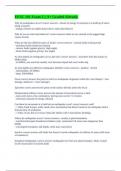Exam (elaborations)
EESC 101 Exam 2 || A+ Graded Already.
- Course
- Institution
Why do earthquakes occur? correct answers - release of energy in response to a build up of stress along a fracture - energy released in sudden bursts due to stick-slip behavior Why do we see stick slip behavior? correct answers faults are not smooth so the jagged edge causes friction What ar...
[Show more]



